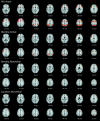N-back working memory paradigm: a meta-analysis of normative functional neuroimaging studies
- PMID: 15846822
- PMCID: PMC6871745
- DOI: 10.1002/hbm.20131
N-back working memory paradigm: a meta-analysis of normative functional neuroimaging studies
Abstract
One of the most popular experimental paradigms for functional neuroimaging studies of working memory has been the n-back task, in which subjects are asked to monitor the identity or location of a series of verbal or nonverbal stimuli and to indicate when the currently presented stimulus is the same as the one presented n trials previously. We conducted a quantitative meta-analysis of 668 sets of activation coordinates in Talairach space reported in 24 primary studies of n-back task variants manipulating process (location vs. identity monitoring) and content (verbal or nonverbal) of working memory. We found the following cortical regions were activated robustly (voxelwise false discovery rate = 1%): lateral premotor cortex; dorsal cingulate and medial premotor cortex; dorsolateral and ventrolateral prefrontal cortex; frontal poles; and medial and lateral posterior parietal cortex. Subsidiary meta-analyses based on appropriate subsets of the primary data demonstrated broadly similar activation patterns for identity monitoring of verbal stimuli and both location and identity monitoring of nonverbal stimuli. There was also some evidence for distinct frontoparietal activation patterns in response to different task variants. The functional specializations of each of the major cortical components in the generic large-scale frontoparietal system are discussed. We conclude that quantitative meta-analysis can be a powerful tool for combining results of multiple primary studies reported in Talairach space. Here, it provides evidence both for broadly consistent activation of frontal and parietal cortical regions by various versions of the n-back working memory paradigm, and for process- and content-specific frontoparietal activation by working memory.
Figures


References
-
- Andersen RA, Buneo CA (2003): Sensorimotor integration in posterior parietal cortex. Adv Neurol 93: 159–177. - PubMed
-
- Awh E, Jonides J, Smith EE, Schumacher EH, Koeppe RA, Katz S (1996): Dissociation of storage and rehearsal in verbal working memory: evidence from positron emission tomography. Physiological Science 7: 25–31.
-
- Baddeley AD (1986): Working memory. New York: Oxford University Press.
-
- Bor D, Cumming N, Scott CEM, Owen AM (2004): Prefrontal cortical involvement in encoding strategies, independent of stimulus modality. Eur J Neurosci 19: 3365–3370. - PubMed
-
- Bor D, Duncan J, Wiseman RJ, Owen AM (2003): Encoding strategies dissociate prefrontal activity from working memory demand. Neuron 37: 361–367. - PubMed
MeSH terms
LinkOut - more resources
Full Text Sources
Other Literature Sources
Medical

